Most dedicated lifters show up to the gym ready to do what it takes to work towards their goals. But it’s not always fun and games, and some workouts are approached with less enthusiasm than others. Leg day usually separates goal-focused lifters from those who’d get a tongue tattoo rather than train. Many leg exercises … Read more
The post How to Do the Bulgarian Split Squat for Leg Size, Strength, and Mobility appeared first on Breaking Muscle.
Most dedicated lifters show up to the gym ready to do what it takes to work towards their goals. But it’s not always fun and games, and some workouts are approached with less enthusiasm than others.
Leg day usually separates goal-focused lifters from those who’d get a tongue tattoo rather than train. Many leg exercises test mental fortitude as much as muscular ability, and the Bulgarian split squat is one of them.
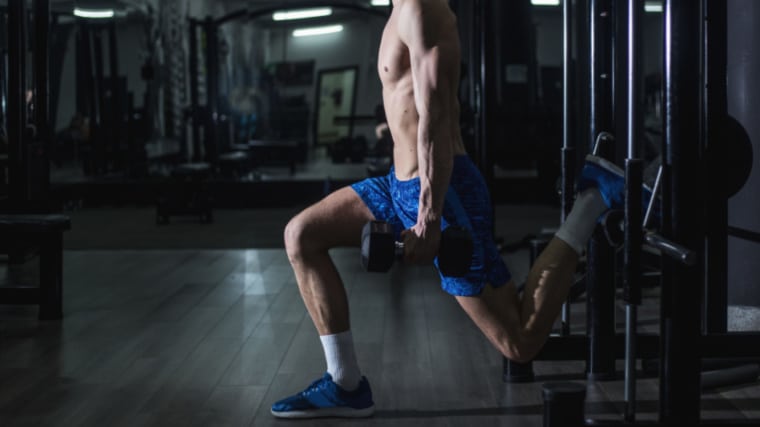
Sometimes called the very wordy “rear foot elevated split squat” or RFESS, the Bulgarian split squat combines single-leg training with a long range of motion (for a deep stretch) to build size, strength, and total-body stability. Here’s why this movement needs to find a spot in your next leg workout.
- How to Do the Bulgarian Split Squat
- Bulgarian Split Squat Mistakes to Avoid
- Benefits of the Bulgarian Split Squat
- Muscles Worked by the Bulgarian Split Squat
- Who Should Do the Bulgarian Split Squat
- How to Program the Bulgarian Split Squat
- Bulgarian Split Squat Variations
- Bulgarian Split Squat Alternatives
- Frequently Asked Questions
How to Do the Bulgarian Split Squat
The Bulgarian split squat may appear intimidating due to the balance factor, but with a proper setup and a few specific cues, you can be knocking out reps in a strong, stable position. Here’s what to focus on.
Step 1 — Set Up the One-Legged Stance
Sit sideways on a flat bench while holding a pair of dumbbells. Extend both legs straight and plant your heels on the ground. Place the foot of your working leg flat on the ground as you stand up without moving your feet from their spots on the ground.
Place your non-working leg on the bench with your shoelaces down. Stabilize your body and pull your shoulders back to keep yourself upright. Allow the dumbbells to hang straight by your sides with your palms facing in towards your body.
Form tip: If a standard flat bench is too high to comfortably place your leg, use a decline bench and place your foot at a lower and more practical height. You can also use a plyo box.
Step 2 — Squat Under Control
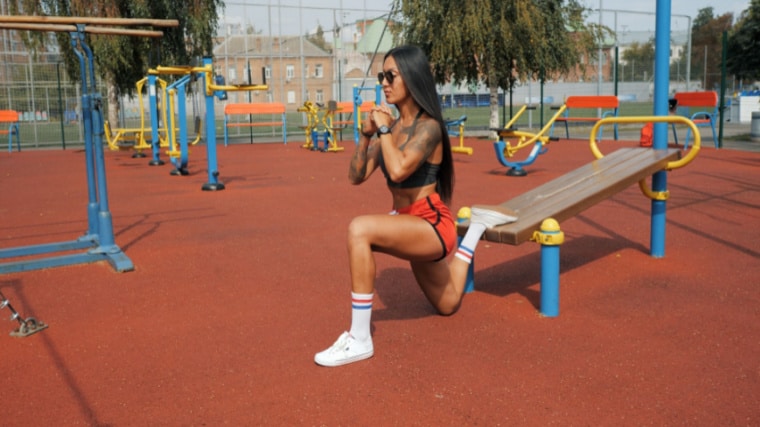
Take a deep breath, flex your core for added stability, and bend your front leg to squat down. Keep your shoulders pulled back and your torso upright. Keep your shoelaces in contact with the bench at all times and don’t rise onto your toes. In the bottom position, your rear knee should approach the ground, if your mobility allows.
As you descend, the hip flexors of the rear leg will undergo a significant stretch which some lifters find uncomfortable. Never force your body into a position it’s fighting against. Over time, your mobility will improve, and your body will adapt.
Form tip: Before you begin the exercise, consider placing a towel or foam block under the spot your rear knee will end up. This gives you a target for consistent depth and offers to cushion in case you descend too quickly and accidentally smash your knee into the ground.
Step 3 — Stand to Lockout
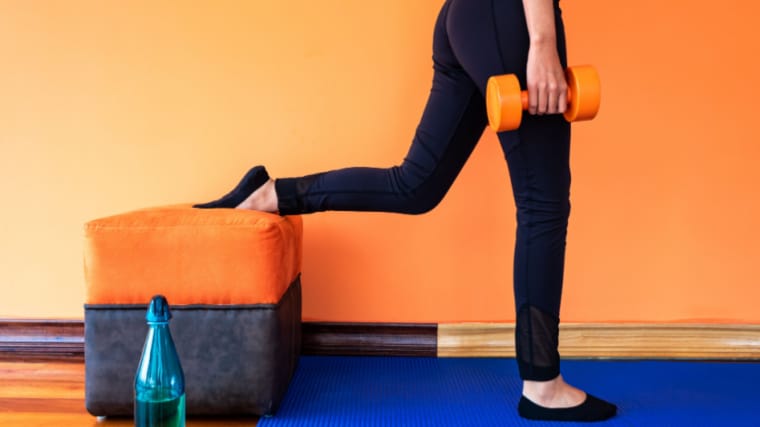
Keep your front foot flat on the ground and press through to return to a standing position. Move at a controlled pace to avoid being knocked off balance. Focus on driving through your front foot and use the back leg passively to maintain balance.
In the top position, your front leg should be locked straight, and your rear leg should be bent at a slight natural angle.
Form tip: As you move during the rep, keep your eyes locked on one fixed point directly in front of you, whether on the wall, on the ground, or a random dumbbell rack in front of your bench. Focusing on a stationary object can help you maintain a sense of balance. Avoid closing your eyes, which can make it more challenging to balance.
Bulgarian Split Squat Mistakes to Avoid
Because the split squat requires more coordination than other exercises, there are several common technique errors that lifters can run into. The balance component of the exercise requires extra attention to detail. Using a slightly slower lifting speed to descend and stand can also help to focus on proper form.
Pressing with Your Rear Foot
The leg that’s planted on the floor will receive the most muscle activation. Your rear leg should be used primarily for balance and stability, not to raise your body from the bottom position.
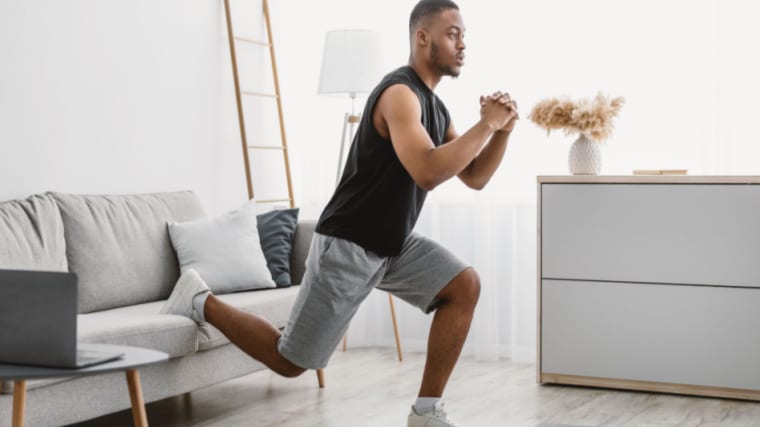
Interestingly, some research has shown that even if you do try to drive up through the rear leg, it’s simply not effective and doesn’t contribute to strength or muscle growth. (1) Also, pressing hard with the rear leg may throw you off-balance, making it counterproductive.
Avoid it: Be sure to keep the shoelaces of your back foot on the bench and use your rear leg to maintain stability.
Hopping Around Too Much
While the Bulgarian split squat does require some sense of balance, wobbling and readjusting between individual reps may be necessary. If it happens excessively, for example, more than two or three times in a single set, you’ll be spending too much time focused on balance and not enough time building strength.

Too many corrections between reps can also reduce the muscles’ time under tension, which will reduce the muscle-building stimulus.
Avoid it: Use the technique cue in step one of the how-to section to generally gauge your stance distance. Sit on the bench, extend your feet, plant them in place, and stand up. Perform several bodyweight-only repetitions to fine-tune your stance before picking up dumbbells for your working set.
Leaning Forward
To be fair, this is a “mistake with an asterisk.” Meaning, it’s technically a mistake if your goal is to target the quadriceps muscles on the front of your thighs, which is the most common purpose of this exercise. Leaning your upper body forward as you squat alters your body’s leverage and reduces quadriceps activation.
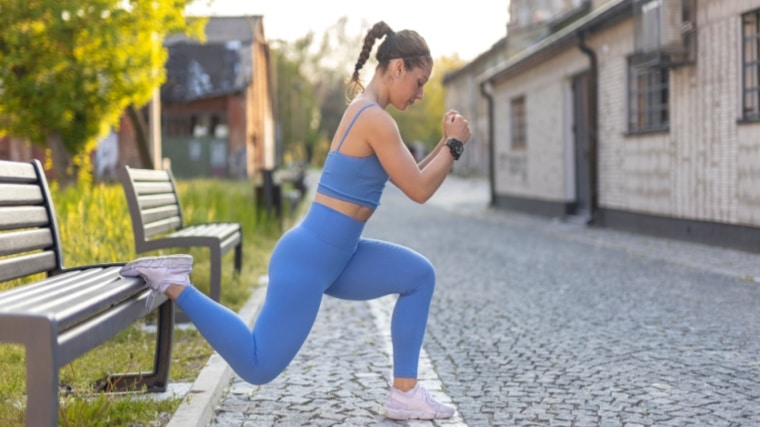
However, if your goal is to target your glutes, then leaning your forward can be the right thing to do. It shifts your center of gravity and creates more of a hip hinge or deadlift-type position which activates the glutes and hamstrings more significantly.
Avoid it: Know that leaning forward as you squat down shifts the exercise from a quad-builder to a glute-builder. If that’s your goal and you’re leaning deliberately to target specific muscles, no problem. But if your goal is to build your quads and you’re leaning forward to balance yourself, then you’re using improper technique.
Benefits of the Bulgarian Split Squat
This movement is a unilateral (single-leg) exercise which helps to address muscular imbalances and strength discrepancies between legs.
View this post on Instagram
Over the long-term, these types of exercises can build more well-rounded development and may reduce the risk of injury. Here are some more convincing reasons to incorporate this exercise.
Leg Size
The Bulgarian split squat allows you to focus work onto the quadriceps, glutes, and hamstrings of the working leg. (2) Because each leg is working individually during a set, the overall muscular tension and muscle-building stimulus is increased compared to working both legs simultaneously during an exercise.
The Bulgarian split squat has also been shown to be less stressful to the knee joint compared to two-legged exercises like the back squat, making it a better choice for lifters dealing with joint pain. (3)
Leg Strength
Most lifters believe you need to load heavy weights onto a barbell if you want to build serious strength. However, the unilateral Bulgarian split squat can deliver comparable strength and power gains compared to bilateral (two-legged) exercises. (4)
Treating the Bulgarian split squat as a heavy main lift while maintaining sound technique can be an extremely effective way to trigger new strength gains.
Lower Body Mobility
Lifting weights is often prioritized over stretching or mobility work because, let’s face it, stretching just isn’t too enjoyable for some people. However, mobility and flexibility training can be just as important for long-term joint health.
Because the Bulgarian split squat puts the rear leg into a stretched position, it’s essentially a “free stretching session,” specifically for the hip flexors. Stretching the hip flexors is associated with reduced lower back pain and improved overall strength performance. (5)
Muscles Worked by Bulgarian Split Squat
Like many squat variations, the Bulgarian split squat activates all muscles of the leg to varying degrees.
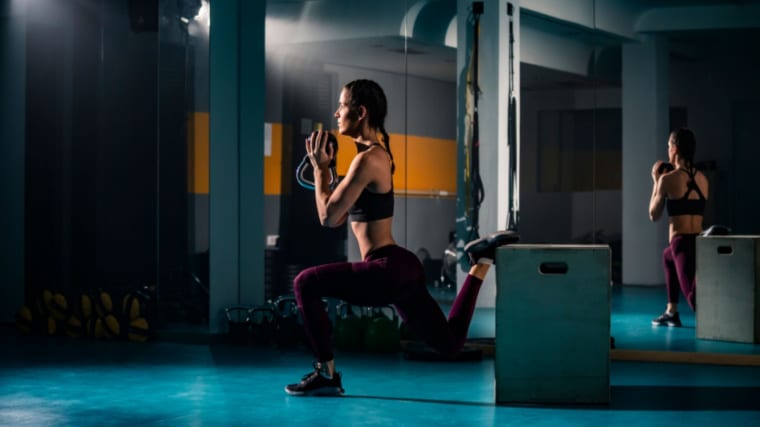
While certain technique adjustments can shift the target muscle focus, it is primarily considered an exercise for the quadriceps.
Quadriceps
The quads, on the front of the thigh, are the largest muscle on the leg. They function primarily to extend your knee and straighten your leg. The Bulgarian split squat works the quadriceps throughout the entire repetition, most significantly in the upper range of motion as you approach a standing, locked out position.
Glutes
The glutes primarily work to extend your hip (straighten your leg from the hips down) and to control leg rotation at the hip joint. The Bulgarian split squat activates both of these functions as you rise out of the bottom position, while also stabilizing your leg to maintain balance. (6)
Hamstrings
While the Bulgarian split squat is typically considered a quadriceps-focused exercise, the hamstrings are engaged and activated during each repetition. Your hamstrings work to bend your knees and (in conjunction with your glutes) extend your hips.
The bottom portion of the exercise recruits the hamstrings significantly to slow your descent and initiate your transition to stand up.
Adductors and Abductors
Your adductors and abductors are your “inner thigh” and “outer thigh” muscles, respectively. They control leg movement, appropriately, in towards your centerline or away from it. During the Bulgarian split squat, these muscles are constantly activated to maintain balance as they micro-adjust to keep the knee of your working leg from buckling in or out.
Who Should Do the Bulgarian Split Squat
The Bulgarian split has gained a burst of popularity in recent years, being used by top-level competitive bodybuilders, elite powerlifters, CrossFit champions, and world-class athletes in a variety of sports. Safe to say, it has something to offer for everyone.
Physique-Focused Lifters
Anyone looking to pack size onto their legs can use the Bulgarian split squat as a key player in their lower body workout. This exercise provides a significant growth stimulus to nearly every leg muscle, except for the calves which don’t undergo any significant range of motion during the movement.
General Sports Athletes
Strength and conditioning coaches in traditional sports have been introducing unilateral exercises like the Bulgarian split squat to build strength and athletic power without significant joint strain. Incorporating unilateral lower body training has been shown to improve power output compared to focusing solely on bilateral training. (7)
Strength Athletes
Competitive powerlifters, strongmen and strongwomen, CrossFit athletes, and other strength athletes don’t have to lift super-heavy to get super-strong. The Bulgarian split squat has been shown to be as beneficial for back squat strength as specifically back squatting. (4)
This makes the Bulgarian split squat an ideal movement for lifters who need to stay on track with strength gains while reducing wear and tear on their joints.
How to Program the Bulgarian Split Squat
Because the Bulgarian split squat can be useful for a number of goals, it can be programmed several different ways. Here are some of the most efficient plans to fit the exercise into your routine.
Moderate Weight, Moderate Repetition
Training this exercise using two or three sets of eight to 12 reps delivers an optimal training stimulus for muscle growth. (8) Because your rear leg is essentially resting while your front leg is working, you can significantly cut down on training time by resting 30 seconds or less between each leg instead of a longer, more traditional rest period after working both legs consecutively. This is an effective intensity-boosting technique.
Heavy Weight, Low Repetition
Once you have an understanding of basic technique, try performing three or four sets of four to six reps with a relatively heavy weight. Going excessively heavy can negatively affect technique, but approaching muscular fatigue in the four to six rep range is a sufficient window to trigger strength gains without compromising form.
Bulgarian Split Squat Variations
The Bulgarian split squat with dumbbells may be too difficult for some lifters, or not challenging enough for others. Here are some similarly effective options to consider.
Trap Bar Bulgarian Split Squat
Using a trap bar to perform the movement opens the potential for loading much heavier weights, making it ideal for experienced lifters who want to build serious single-leg strength.
Depending on your arm and leg length, the trap bar should not make contact with your rear leg at any point during the exercise. Perform the exercise slowly with an unloaded bar to check your individual range of motion.
Safety Bar Bulgarian Split Squat
The safety bar is sometimes called a lifter’s secret weapon because it allows many of the same benefits of squatting with a straight barbell, plus some added bonuses. The thick bar pad raises the weight from your center of gravity, which increases recruitment of the upper back muscles. The forward handles also reduce shoulder strain by allowing a more natural gripping position.
With this Bulgarian split squat variation, maintaining an upright torso will be even more important because the bar will work to collapse you forward. This makes it an ideal exercise for reinforcing strict quad-building technique.
Plyometric Bulgarian Split Squat
This explosive jumping movement is ideal for athletes looking to build agility and power. It’s also a highly effective choice for any lifters looking to fire up their nervous system for improved performance prior to heavy lifting. (9)
Begin with bodyweight only — adding resistance with dumbbells or a weighted vest is for highly experienced lifters. Focus on applying maximum power to achieve height with each jump.
Bulgarian Split Squat Alternatives
Some lifters aren’t able to perform the Bulgarian split squat due to immobility, coordination issues, or other factors. These are some comparably effective single-leg exercises for size and strength.
Reverse Lunge
The reverse lunge allows you to focus on one leg at a time while reducing knee joint strain. This movement also helps to eliminate the balance component of the exercise, making it a better choice for lifters who had trouble balancing on one foot for the duration of a set.
A number of other lunge variations could also be used — forward lunge, walking lunge, etc. — but the reverse lunge is the most effective and most general movement for the majority of lifters.
Step-Up
The step-up can be highly effective when performed correctly. Unfortunately, it’s often performed incorrectly which compromises its benefits. It’s essential to focus on driving up through the elevated foot, not the foot on the ground.
Many lifters make the mistake of bouncing off their bottom foot, which generates momentum and reduces the work done by the leg on top of the box.
Single-Leg Leg Press
This is the most stable and least balance-demanding exercise of the lot. The leg press provides total stability while still allowing single-leg focused training. This movement also allows a significant load to be used because it’s not supported by your back, shoulders, or arms.
Be sure to sit fully in the chair support. Don’t rotate, shift, or twist while pressing with the working leg because you can increase the risk of injury.
FAQs
I feel my back leg working more than my front leg. How do I fix it?
This is often due to poor hip flexor mobility, which is a common issue for many lifters. The Bulgarian split squat puts the rear leg into a forced stretch position.
If you currently lack mobility, that muscle will be the “weak point” and you’ll feel fatigue or discomfort there before the target muscle is sufficiently trained. Your body will adapt and improve as you practice the exercise, just be sure to work within a comfortable range of motion and gradually push yourself.
Why does this exercise make me more sore than any other leg exercise?
Several variables contribute to “delayed onset muscle soreness” or DOMS, which is the technical term for post-workout soreness. One of the most significant causes is the eccentric stress which occurs when a weight is lowered or a muscle is lengthened. (10)
While every exercise has an eccentric phase, the Bulgarian split squat is typically performed at a relatively slower pace in order to maintain balance and focus. This increases the duration of the eccentric and can increase DOMS.
This doesn’t mean you should lower yourself quickly, because that would be counterproductive and decrease the muscle-building stimulus. Your body will adapt, especially when supported by ample nutrition for growth and repair.
Step Back to Get a Leg Up
Whether you call it the Bulgarian split squat, the rear foot elevated split squat, the RFESS, or the “weeble wobble one-leg bench squat,” stick with it and you’ll soon be calling it your ticket to bigger, stronger legs. Don’t let a little balance requirement scare you away from this powerful and productive movement.
References
- Helme, M., Emmonds, S., & Low, C. (2022). Is the Rear Foot Elevated Split Squat Unilateral? An Investigation Into the Kinetic and Kinematic Demands. Journal of strength and conditioning research, 36(7), 1781–1787. https://doi.org/10.1519/JSC.0000000000003727
- McCurdy, Kevin. (2017). Technique, Variation, and Progression of the Rear-Foot-Elevated Split Squat. Strength and Conditioning Journal. 39. 1. 10.1519/SSC.0000000000000319.
- Mackey, E. R., & Riemann, B. L. (2021). Biomechanical Differences Between the Bulgarian Split-Squat and Back Squat. International journal of exercise science, 14(1), 533–543.
- Speirs, D. E., Bennett, M. A., Finn, C. V., & Turner, A. P. (2016). Unilateral vs. Bilateral Squat Training for Strength, Sprints, and Agility in Academy Rugby Players. Journal of strength and conditioning research, 30(2), 386–392. https://doi.org/10.1519/JSC.0000000000001096
- Konrad, A., Močnik, R., Titze, S., Nakamura, M., & Tilp, M. (2021). The Influence of Stretching the Hip Flexor Muscles on Performance Parameters. A Systematic Review with Meta-Analysis. International journal of environmental research and public health, 18(4), 1936. https://doi.org/10.3390/ijerph18041936
- McCurdy, Kevin; Walker, John; Kelly, Camila; Polinski, Michael. Hip and Knee Extensor Activation During the Hip Thrust and Rear-Foot–Elevated Split Squat in Trained Females. Journal of Strength and Conditioning Research: May 2021 – Volume 35 – Issue 5 – p 1201-1207 doi: 10.1519/JSC.0000000000004035
- Ramirez-Campillo, Rodrigo & Burgos, Carlos & Henríquez-Olguín, Carlos & Andrade, David & Martínez, Cristian & Álvarez, Cristian & Castro-Sepulveda, Mauricio & Marques, Mário & Izquierdo, Mikel. (2015). Effect of Unilateral, Bilateral, and Combined Plyometric Training on Explosive and Endurance Performance of Young Soccer Players. The Journal of Strength and Conditioning Research. 29. 1317–1328. 10.1519/JSC.0000000000000762.
- Schoenfeld, B. J., Contreras, B., Krieger, J., Grgic, J., Delcastillo, K., Belliard, R., & Alto, A. (2019). Resistance Training Volume Enhances Muscle Hypertrophy but Not Strength in Trained Men. Medicine and science in sports and exercise, 51(1), 94–103. https://doi.org/10.1249/MSS.0000000000001764
-
Davies, G., Riemann, B. L., & Manske, R. (2015). CURRENT CONCEPTS OF PLYOMETRIC EXERCISE. International journal of sports physical therapy, 10(6), 760–786.
- Lieber, Richard & Fridén, Jan. (2002). Morphologic and Mechanical Basis of Delayed-Onset Muscle Soreness. The Journal of the American Academy of Orthopaedic Surgeons. 10. 67-73. 10.5435/00124635-200201000-00009.
Featured Image: MexChriss / Shutterstock
The post How to Do the Bulgarian Split Squat for Leg Size, Strength, and Mobility appeared first on Breaking Muscle.







